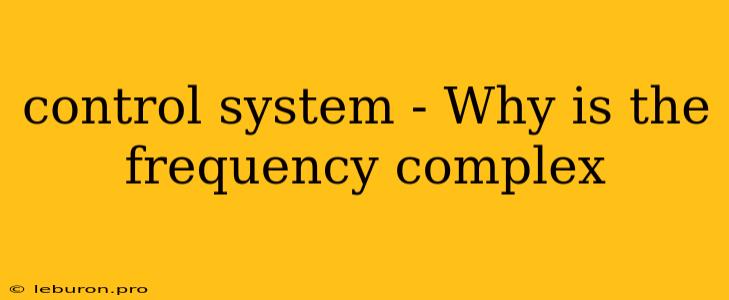The realm of control systems is intricately interwoven with the concept of frequency, a fundamental aspect that governs the behavior and performance of these systems. While frequency itself is a familiar concept, its manifestation as a complex number within the context of control systems often sparks curiosity and a desire for deeper understanding. This article delves into the rationale behind representing frequency as a complex quantity, exploring the underlying reasons and the implications it holds for analyzing and designing control systems.
The Essence of Frequency in Control Systems
At its core, frequency signifies the rate at which a system oscillates or varies over time. In control systems, the concept of frequency plays a crucial role in characterizing how the system responds to different input signals, particularly those that are periodic or oscillatory in nature. For instance, consider a simple feedback control loop where the output of a system is fed back to the input to regulate its behavior. The system's response to sinusoidal inputs, which are characterized by their frequency, is a key indicator of its stability and performance.
Why Frequency Becomes Complex
To comprehend why frequency becomes complex in control systems, we need to delve into the mathematical framework used to analyze these systems. The primary tool employed is the Laplace transform, a powerful mathematical technique that transforms time-domain signals into frequency-domain representations. This transformation allows us to express the system's dynamics and responses in terms of frequency, providing a more convenient and insightful perspective.
The Laplace Transform and Complex Frequency
The Laplace transform, denoted by the symbol "s," maps a time-domain signal, x(t), to a frequency-domain function, X(s). The complex variable "s" is defined as:
s = σ + jω
where:
- σ represents the real part of "s" and corresponds to the exponential decay or growth of the signal.
- j is the imaginary unit (j² = -1).
- ω represents the imaginary part of "s" and corresponds to the angular frequency of the signal (in radians per second).
Frequency as a Complex Number
The presence of the imaginary unit "j" in the definition of "s" inherently introduces complexity into the frequency representation. While the real part of "s" (σ) captures the damping or growth of the signal, the imaginary part (ω) characterizes its oscillation or frequency. The complex nature of "s" allows us to encompass both the damping/growth behavior and the oscillatory behavior of the system within a single mathematical construct.
The Significance of Complex Frequency
The use of complex frequency in control systems offers significant advantages:
-
Unified Representation: Complex frequency provides a unified framework for analyzing both transient and steady-state behavior of control systems. The real part captures the transient response, while the imaginary part reflects the steady-state behavior.
-
Frequency Response Analysis: Complex frequency is instrumental in the concept of frequency response analysis, which explores the system's output for different sinusoidal input frequencies. This analysis helps determine the system's stability, gain, and phase shift at various frequencies.
-
Pole-Zero Analysis: The complex frequency is intimately linked to the concept of poles and zeros in the system's transfer function. Poles and zeros, which are complex numbers representing the system's natural frequencies, provide valuable insights into the system's stability, transient response, and frequency response characteristics.
-
System Design and Optimization: Complex frequency plays a pivotal role in the design and optimization of control systems. By carefully selecting the location of poles and zeros in the complex plane, engineers can tune the system's frequency response, ensuring stability, desired performance, and robustness.
Conclusion
The representation of frequency as a complex quantity in control systems is not merely a mathematical artifact but a necessity driven by the underlying mathematical framework and the need to capture both transient and steady-state behaviors. By embracing the complex frequency, we gain a powerful tool for analyzing, designing, and optimizing control systems, enabling them to function efficiently and reliably in a wide range of applications.
